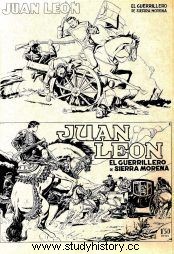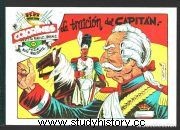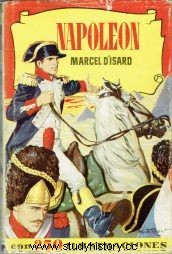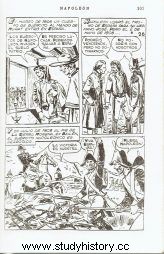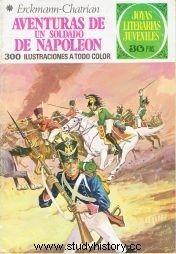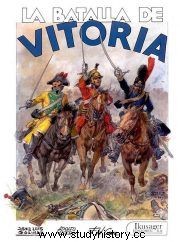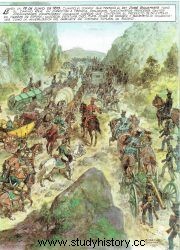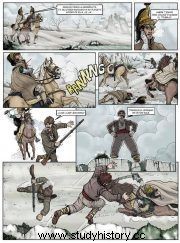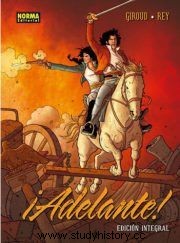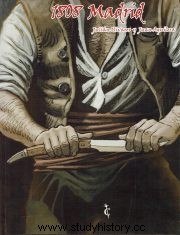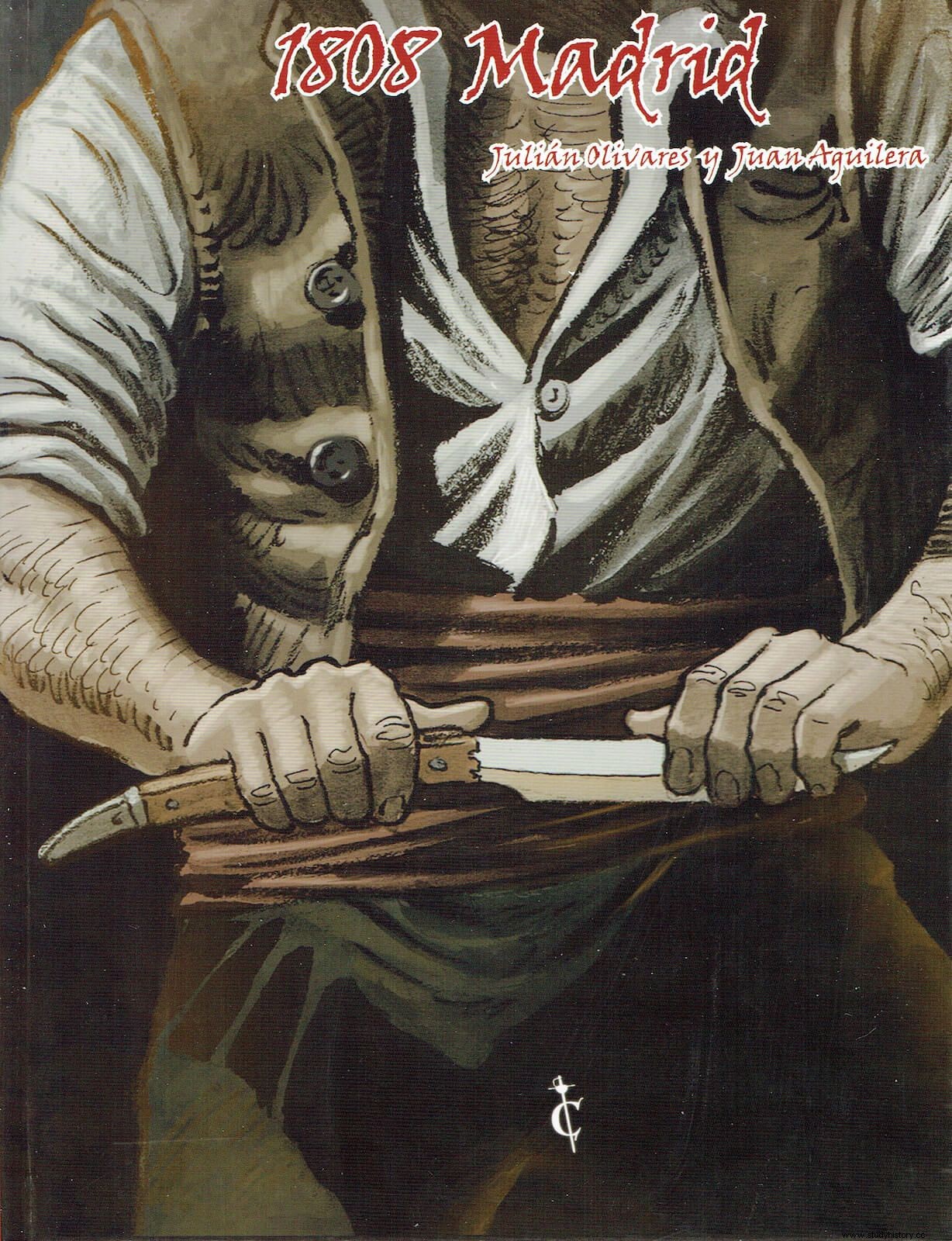
The transmission of the ideological structure during the Franco regime had a clear reflection in the field of comics. If the political evolution of the regime can be traced through the scripts and characters of widely popular series such as Hazañas Bélicas , and the values of Christianity and the importance of the Reconquest in the definition of the construction process of the Spanish identity story in the Middle Ages is shown in El Guerrero del Antifaz , in which the essential contribution of religion is included in the definition of the script and the characters, the War of Independence , as a symbol of the fight against the invader and crucible of the essential values of the country, was also used. In this case, it was a matter of following an argumentative line born in the field of academic historiography already in the first half of the 19th century, and continued uninterruptedly as one of the essential milestones of the identity cohesion of Spain, to the extent that during The Civil War will be used as a reference by both sides from the same perspective:the fight against the invader and the exaltation of the defining values of the opposing ideologies.
In 1942, the weekly Chicos (1938-1955), directed by Consuelo Gil Roësset de Franco (1905-1995), published the story The Knight Without a Name , with a script by José María Huertas Ventosa (1907-1967) and drawings by Emilio Freixas Aranguren (1899-1976), probably the best of all the titles to be published during this period (Fig.1). Freixas's drawings and composition are innovative in distancing themselves from the regular orthodoxy of other publications, and the movement of the figures, and even the treatment of their volumes and faces, recall American series such as Flash Gordon by Alex Raymond (1909-1956). The documentation work is very interesting for the time, and some of the figures during the combat scenes are reminiscent of the work of Joaquín Sorolla (1863-1923), Defense of the artillery park of Monteleón (1884). The comic, which will be followed by two other installments, Spanish Guerrillas (1943) and The game of the hat (1944), of lesser quality as it retakes the classic montage in vignettes and introduces the texts in speech bubbles, abandoning the continuous narrative outside the drawings that had characterized the first installment, and neglecting the setting, it introduces one of the essential concepts of most of the titles that will be published next:the double life of the hero who acts undercover, in this case as a result of a class contempt, which will be repeated in 2014 in the main character of the album Forward ! . The figure of the masked man is taken up again in the series Black cape (1953) edited by Exclusive Gráficas Ricart, based on a script by Salvador Dulcet Altés (1914-1987) with illustrations by Ángel Badía Camps (1929-2019), which recounted, throughout seventeen installments, the adventures of a nobleman, Diego Miranda, who, protected by his pusillanimous and helpful attitude towards the French, can develop a double life as the masked hero who continuously puts the invaders in trouble, becoming a popular legend. A plot that has obvious literary and cinematographic references. The Black Cloak character It can be considered as the precedent of the TVE series, The black mask (1982), whose plot line based on the adventures of a playboy and womanizing nobleman well connected with the Spanish social elites and with the French occupiers, but in reality an active guerrilla, is identical.

Manuel Gago García (1925-1980), one one of the most influential Spanish comic writers and illustrators, he is responsible for two works on the War of Independence. In 1943 he published in Editorial Valenciana the story Revenge and war , set in the events of Dos de Mayo, a youth work with a simple drawing that already shows the compositional form that will characterize his main work, El Guerrero del Antifaz , but in which both the definition of the characters and the setting are very simple. Almost twenty years later, in 1962, an already consecrated Gago would make a new approach to the subject in the twenty-six installments of the series Guerrillero Audaz, that would be canceled due to lack of acceptance, since the plot was well known, since the protagonist, Diego, acts to avenge the death of his father at the hands of the French again during the days of Dos de Mayo , exalting as it was forced the character of popular revolt that was conferred to most of the series of the time. The figure of the guerrilla as the central axis of the resistance had previously been used in three publications:El tambor de granaderos (1954), with a script by Miguel González Lasquel and drawings by Santiago Martín Salvador (1935) published in the magazine Chicos, whose plot focuses on the first guerrilla games of the war in Catalonia and the sieges of Girona; Juan León, the guerrilla from Sierra Morena published by Ediciones Toray with a script by Federico Amorós Martín (1914-1991) and drawings by José Grau Hernández (1914-1998), a work that would be republished in the 1980s and that is an example of the indicated ideological line of opposition between the well, embodied by the figure of the hero, a paragon of virtues, intelligence and love for the country, and the conception of evil embodied by the French and their Spanish allies, examples of perfidy, cruelty and stupidity in a clear Manichaean structure designed to build the figure of an invincible folk hero (Fig. 2). A third series is Luis Valiente (1957), with a script by Pedro Muñoz and drawings by Matías Alonso Andrés (1935) whose plot, the tireless but unsuccessful pursuit of a guerrilla fighter by his antagonist, Captain René, is a clear adaptation of the confrontation between El Empecinado and General Hugo (Fig.3). A fourth and final notebook series is Sergeant Fury , edited in 1962 by Editorial Bruguera from a script by Juan Antonio Vidal Sales, Cassarel (1921-2008) and drawings by Juan Escandell Torres (1937), in which the publisher tried to repeat the formula of the two most successful series of the time:The Thunder Captain (started in 1956) and El Jabato (appeared in 1958), through the structuring of a leading trio in which a weak boy and a noble strongman of not excessive intelligence appear next to the hero. The series was canceled after thirty-six notebooks were published, although the publisher, faithful to its policy of recovering old material, reissued it in 1978.
- Figure 2
- Figure 3
During the seventies there was a gap in the translation of the Napoleonic theme to comics in Spain. It is worth mentioning, as an example, the publications of Editorial Bruguera, the dominant company in the sector, which in 1977 included in its series of notebooks Juvenile Literary Jewels an adaptation of the novel by Émile Erckman (1822-1899) and Alexandre Chatrian (1826-1890), Histoire d’un conscrit de 1813 (1864), repeatedly published in Spanish under the title Adventures of a Napoleon soldier (Fig.6). The adaptation of the text was carried out by Alberto Cuevas Hortelano, the interior drawings correspond to Alfonso Cerón Núñez (1928) and the cover was the work of Antonio Bernal Romero (1924-2013). With a simple outline, the interest of the work lies in its script and not in the setting, which at no time pretends to be rigorous, but rather vaguely recalls a certain Napoleonic aesthetic. Bruguera also edited, from the mid-1950s, the collection Historias Selección , a fortnightly adaptation of great classic works of universal literature and biographies of famous people that included a graphic page every three of text. Within the series Napoleon was published (1959), based on a script by Marcel d'Isard –one of the most prolific authors in the collection–, while the illustrations were made by Jaime Juez Castellà (1906-2002), an artist who did a good job of documenting and whose narrative structure is very solid throughout the more than 250 drawings included in the work. In the first edition of 1959, the dust jacket was made by Vicente Roso Mengual (1920-1996) and the title page by Pedro Alférez González (1925-1987), both of which varied in the successive reissues made by the publisher, which even modified the size on occasions. from the book. In any case, a remarkable work with a wide popular impact, since a generation of adolescents between the second half of the 1950s and the end of the next, approached reading and History through Bruguera's publications. (Fig. 4 and 5).
- Figure 4
- Figure 5
- Figure 6
In 1985, Ikusager Ediciones, within the collection Images of History, published what, without a doubt, continues to be the best album published in Spain about the war:The Battle of Vitoria , an excellent fresco based on a script by Felipe Hernández Cava (1953) with drawings by José Luis Salinas (1902-1985), who conceived the graphic project but whose death only allowed him to finish the cover and the first six pages, and Adolfo Usero Abellán (1941), who completed the work by adapting his most direct style to the precious rigor of Salinas. Unlike previous and later works, the book is the reflection of exhaustive documentation in which errors are very few despite representing different units of the French, British, Spanish and Portuguese armies. The script, as Mario Onaindía (1948-2003) indicated, is not limited to the narration of Wellington's decisions, the doubts of King José and Marshal Jourdan, or General Reille's attempts to turn the defeat into an orderly retreat, but that shows a parallel plot that narrates the suffering of the civilian population, from the members of the famous convoy described by Benito Pérez Galdós, to the inhabitants of Vitoria immersed in the clash. But the importance of the story lies in its distancing from the heroic and patriotic character of most of the works of the genre, and points to elements that are unusual in the date of publication, such as the reference to the brutality of the British troops against a theoretically allied civilian population. –a behavior that in the Basque Country has an outstanding example such as the looting of San Sebastián on August 31, 1813, two months after the battle–, and the definition of the War of Independence as the first civil war of the Spanish 19th century by contrasting the role of two brothers, one a soldier in the Spanish army and the other in the Josephine army. In addition, anticipating the prevailing vision at the time of the battle over El Deseado, the text does not spare criticism of the involution that will befall Spain after the return of absolutism embodied by Ferdinand VII and the repressive role of the Inquisition (Figs. 7 and 8).
- Figure 7
- Figure 8
The repression against those who fought against the French invasion but criticized the return to the forms of government of the Old Regime, sidelining the reforming attempts exemplified by the Constitution of 1812, is reflected in the album El Empecinado (2019), edited by Cascaborra within the collection History of Spain in vignettes . A work by Miguel Gómez Andrea (GOL) and Agustín Garriga Botello, it has a historical introduction by Israel Vera. Unlike the previous one, and although it follows the realistic concepts of the clear line, the composition of the image is completely contemporary, incurring repeated uniformological errors (Fig. 9). However, the interest lies in the script, given that it not only reconstructs the life trajectory of Juan Martín Díez, but also includes his reluctance towards the role of the British troops in the Peninsula, which brings the composition closer, to a certain point, to the construction of the character in the RTVE series, The disasters of war (1983) in which the actor Sancho Gracia (1936-2012) played El Empecinado and Bernard Fresson (1931-2002) to his bitter opponent General Leopoldo Hugo. Social conflicts are also part of the plot of the album ¡ Go ahead! (2015), published in an integral edition by Norma[1], based on a script by Frank Giroud with drawings by Javi Rey. As in most of the works reviewed in this article, documentation problems, anachronisms and iconographic errors are recurrent, given that the authors' objective is not the detailed reconstruction of an era, but to use the Napoleonic invasion as a setting for the development of a plot that unites the fight against the French army with social intrigues and the reflection of the persistence of class differences maintained and expanded in a troubled time[2]. The central character, the peasant Ángel Talavera, nicknamed El Libertador –a nickname whose double meaning is evident–, who not only raises a guerrilla in Andalusia in 1808 carrying out a series of harassments that will culminate in the battle of Bailén, but, due to Giroud's story, also becomes a leader social society that fights for the emancipation of the peasantry, yearns for the end of latifundismo through the realization of a broad agrarian reform, and even believes in the ideals of transformation emanating from the French Revolution (Fig. 10). Some ideas that, obviously, collide with the conservative vision of the Seville Board, whose members are suspicious of the social movement that could continue the expulsion of the French. Obviously, in a comic based on the guerrilla in Andalusia, the references to an icon like Curro Jiménez, recognized by the cartoonist Rey, who based himself on him to give the character in the drawing "an Andalusian and bandit touch" are taken for granted. . To highlight the contemporary thought and way of proceeding of the female protagonist, probably one of the greatest anachronisms in history, although in no case was it, on the part of the authors, a millimetric reconstruction of General Dupont's campaign in Andalusia.
- Figure 9
- Figure 10
How could it be otherwise, the main clashes of the war have their own albums. In this sense, the aforementioned collection History of Spain in vignettes stands out. de Cascaborra Ediciones, in which three titles have been published to date:1808. Madrid with script by Julián Olivares, drawings by Juan Aguilera and color by Aguilera himself and Roxana Urra; 1805. Trafalgar, with a script by Olivares and drawings by Daniel Torrado, and 1808. Bailen , with a script by Carlos Hairstyle and drawings by Kepa de Orbe, with a new album dedicated to the sites of Zaragoza planned. The second and third are simple in structure in terms of drawing, the most interesting of the three is the one dedicated to the popular uprising on May 2 in Madrid. The script gathers the basic ideological references that readers expect to find, from the charge of the Mamelukes to the reconstruction of the iconic The firing squads of May 3rd by Francisco de Goya (Fig. 11). Conceptually, the script has two clear references that converge in the same person:Arturo Pérez-Reverte. On the one hand, the commemorative exhibition of the bicentennial of the events organized by the Community of Madrid:May 1808-2008. Madrid. One people, one nation[3] , and the book of him A day of anger (2007) in which he takes a detailed tour in an interesting microhistory exercise. Some of the plot lines of the album are extracted from both, especially the request made by the prisoners of the Royal Prison of Madrid to be released –on parole to return to prison– and join the fight against the French. A second idea, much more ideological, sublimates the concept of people, and equates it to the idea of nation, wrongly assuming that in the period of the absolutist Bourbon monarchy there was already such awareness of belonging to a politically based collective body among the Spanish population. and, especially, among the popular classes. The composition and the drawing respond to a contemporary conception in which the action scenes prevail over the pause in the story, but the reconstruction of the uniforms, especially of the French troops, but also of the Spanish ones, presents multiple errors that would have been easy to avoid.
- Figure 11
The review carried out is not exhaustive. There are other works, essentially focused on the explanation of historical facts conceived as a didactic resource that have been published during the last two decades. Being edited by the best Spanish illustrator, Dionisio Álvarez Cueto (1964-2008), it is worth highlighting among them Madrid 1808. The Dos de Mayo counted for all (2008) edited by Las Cuatro Plumas with texts by Miguel Ángel Martín. However, the aforementioned albums represent a clear evolution of the concept of illustration of a certain historical period and also of the form of ideological approach to it.
Bibliography
- Alcantarilla Hidalgo, F.J. (2017):The 20th century in vignettes. Barbarism and humanism in European comics. Coeditum. Barcelona.
- Lafon, J-M. (2003):“La Guerra d’Indépendance espagnole (1808-1814) à travers la bande dessinée francophone”. Revue Souvenir Napoléonien , 446, p. 18-31.
- Maroto de las Heras, J. (2001):“The War of Independence in comics”. In:Armillas. J.A (coord.):The War of Independence:studies . I, p. 387-416.
- Maroto de las Heras, J. (2007):War of Independence. Images in film and television . Cacitel.S.L. Madrid.
- Maroto de las Heras, J. (2018):“Vignettes about a war. The war of independence in comics”. Army , 926, p. 55-67.
- It is essential to consult the blog of Jesús Maroto de la Heras, which includes pdfs of several of the works cited:http://jesusmaroto.es/tebeos.aspx
Notes
[1] It was initially published in France by Dupuis, in two volumes in 2014.
[2] https://www.rtve.es/noticias/20150528/adelante-war-independencia-espanola-comic-arrives/1150400.shtml
[3] The content of the exhibition can be expanded at:http://www.icorso.com/2demayo/la-exposicion/ and in its catalog:AA .VV. (2008):Madrid, May 2, 1808. One people, one nation . Madrid's community. Madrid.

